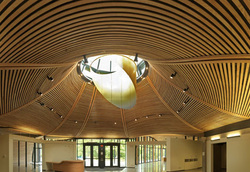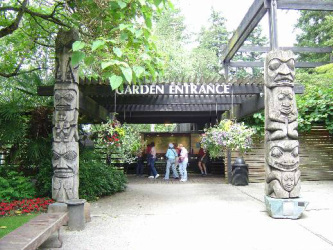
Updates 2013 (HM)
As of 2013, the buildings present at the original opening of the Garden in 1975 are still in use. They have been renovated and incorporated as much as is possible into the overall theme of sustainability, energy efficiency and environmental sensitivity that the Garden wishes to promote.
The new 1,765 sq. m. (~19,000-sq.-ft.) Visitor Centre was designed by Perkins+Will. It was formally opened on October 23rd, 2011.
With its distinctive yew exterior door handles, interior ceiling of wavy rib-patterned Douglas-fir backed with black, mineral wool fabric, central oculus and stylish profile, this cutting-edge building has been specifically designed to raise the Garden's profile by making the entrance more visible to everyone travelling along the street in front. The orchid-inspired design for the roof’s shape creates a visual and ecological balance between the building and the landscape.
It was designed to meet the Leadership in Energy and Environmental Design (LEED) Platinum level of excellence, which requires buildings to excel in terms of energy efficiency, overall environmental sensitivity and sustainability. The new Visitor Centre is also being registered for Living Building Challenge (LBC) status. LBC is an even more rigorous measurement of building sustainability and excellence than LEED, as it requires close monitoring and assessing of a building’s long-term performance in seven key areas: site, water, energy, health, materials, equity and beauty for a full year before certification can be achieved.
This type of innovative, sustainable construction does not come cheap:
As of 2013, the buildings present at the original opening of the Garden in 1975 are still in use. They have been renovated and incorporated as much as is possible into the overall theme of sustainability, energy efficiency and environmental sensitivity that the Garden wishes to promote.
The new 1,765 sq. m. (~19,000-sq.-ft.) Visitor Centre was designed by Perkins+Will. It was formally opened on October 23rd, 2011.
With its distinctive yew exterior door handles, interior ceiling of wavy rib-patterned Douglas-fir backed with black, mineral wool fabric, central oculus and stylish profile, this cutting-edge building has been specifically designed to raise the Garden's profile by making the entrance more visible to everyone travelling along the street in front. The orchid-inspired design for the roof’s shape creates a visual and ecological balance between the building and the landscape.
It was designed to meet the Leadership in Energy and Environmental Design (LEED) Platinum level of excellence, which requires buildings to excel in terms of energy efficiency, overall environmental sensitivity and sustainability. The new Visitor Centre is also being registered for Living Building Challenge (LBC) status. LBC is an even more rigorous measurement of building sustainability and excellence than LEED, as it requires close monitoring and assessing of a building’s long-term performance in seven key areas: site, water, energy, health, materials, equity and beauty for a full year before certification can be achieved.
This type of innovative, sustainable construction does not come cheap:
|
Building Cost:
City: Government of Canada: Member Association: Province: Total: |
$8.3 million $6.9 million $4.7 million $2.0 million $21.9 million |
Besides being innovative, this is a functional, multi-purpose building. It has a number of different spaces, including three rental rooms which combine to form one great room; a library that will be the largest botanical library in Western Canada; a garden store; a discovery room with rotating exhibits; a dedicated classroom for some of the Garden’s many courses and workshops; a volunteer lounge for the more than 1,400 volunteers; and a cafe.
Special features include:
Special features include:
- A green roof to replace the green space on which the building now sits
- Systems for recovering “grey water” (water used for washing hands and dishes) and “black water” (toilet water) that will be cleaned and released into the garden.
- Environmentally responsible, non-toxic building materials. All materials used for construction have been rigorously researched for material health at all levels of their life cycle. All wood used in construction is FSC (Forest Stewardship Council) certified.
- The undulating roof is made of glulam (glued laminated timber) with post-and-beam support.
- Re-use of salvaged material. Examples include the 'new' bridge from a former covered walkway and the large interior wooden doors recycled from Seattle, Washington.
- The surrounding landscape features native plants adapted to the local climate. The plant labels indicate the English, Latin and Musqueam (local First Nations) names.
- Net-zero and therefore 'carbon neutral' energy design meaning that the building uses only as much energy as it produces on an annual basis.
- Solar photovoltaic arrays that provide electricity and solar hot water tubes that produce domestic hot water as well as providing heat.
- A Geothermal energy collection system that uses deep boreholes and underground water storage to provide heating and cooling.
- An Oculus / Solar chimney that provides light, heat in winter and cooling in summer.
